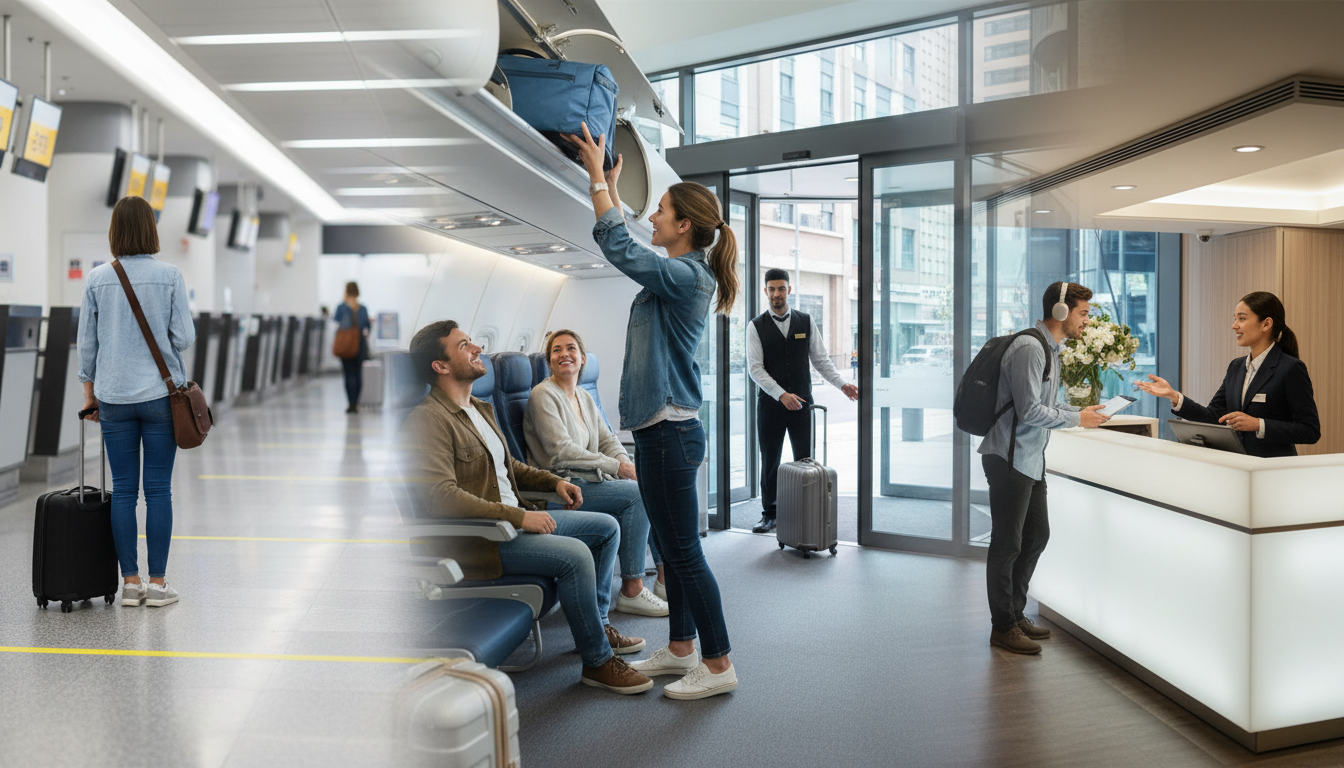Travel Etiquette: Your Friendly Guide to Being a Respectful and Enjoyable Traveler
Travel etiquette has a boring reputation, kind of like the airplane safety card no one reads until there’s turbulence. But here’s the funny thing: once you start paying attention to travel etiquette, you realize it’s the quiet superpower behind every great trip. It’s the difference between being the traveler people are happy to help—and the one they rant about in the group chat later.
When you understand basic travel etiquette—how to behave at airports, on planes, in public spaces, at dinner tables, and inside sacred places—you don’t just avoid cringe-worthy moments. You move through the world with a little more ease, a little more confidence, and a lot more connection.
In this guide, I’ll walk you through practical, real-world travel etiquette: airport manners, plane behavior (yes, we’re settling the armrest debate), public transport rules, cultural customs, and those tiny kindnesses that make you the traveler people are secretly glad to sit next to. Think of this as your travel etiquette cheat sheet, written by someone who’s made the mistakes so you don’t have to.
Ready? Let’s go.
Why Travel Etiquette Matters More Than You Think
I used to treat travel like a personal adventure movie where I was the main character and everyone else was background. Then I actually started paying attention—and I realized something slightly uncomfortable: for the people who live in the places we visit, we are the background.
That’s where travel etiquette comes in. It’s not about memorizing a textbook of rules. It’s about remembering that when you travel, you’re walking through someone else’s home, commute, grocery store, or place of worship.
Picture this: you’re in the Middle East, sitting cross-legged, and you absentmindedly point the soles of your feet toward someone. Or you’re in Japan, proudly leaving a huge tip to show your appreciation—and your server looks visibly stressed because tipping there can feel insulting. Those are tiny examples of how easy it is to step on cultural toes without meaning to.
Researchers have actually looked at this. A study in the Journal of Travel Research found that tourists who were seen as respectful and culturally aware reported better interactions with locals and higher overall satisfaction with their trips. In plain language: when you practice basic travel etiquette, people treat you better, and your trip genuinely feels better.
On a personal level, I’ve noticed that when I care about this stuff, I relax more. I’m not constantly wondering, “Am I being rude right now?” I’ve done enough homework to feel grounded, so I can actually enjoy where I am instead of silently panicking about it.
Pre-Trip Prep: Setting Yourself Up for Success
Good travel etiquette starts before you board the plane. A little prep on your couch saves you a lot of weirdness later.
Learn a Few Local Phrases
If I had to pick one habit that consistently improves my trips, it’s this: learn a handful of words in the local language.
Nothing fancy. Just:
- Hello
- Please
- Thank you
- Sorry
- Do you speak English? (or your language)
I’ve mangled “thank you” in half a dozen languages and still watched people light up because I tried. It’s not about perfection; it’s about effort. Language researchers talk about “effort signals”—small things that show you’re trying to meet someone halfway. Even a clumsy “grazie” or “arigato” says, “I know this is your home, not my theme park.”
And there’s a selfish perk: people are usually kinder and more patient when they see you’re making an effort. Travel etiquette that helps both sides is my favorite kind.
Check Cultural Norms and Dress Codes
The other pre-trip power move is checking basic cultural norms.
Ten minutes of research can tell you:
- How modest people typically dress.
- Whether shoulders and knees need to be covered at religious sites.
- If you’ll need to remove shoes in temples, mosques, or homes.
- Any gestures or behaviors that are considered really rude.
I now have a permanent “respect outfit” that goes in my suitcase: breathable pants or a long skirt, and a light top that covers my shoulders. That combo has gotten me into churches in Italy, temples in Thailand, mosques in Turkey, and I don’t have to scramble to buy an emergency scarf from a tourist stand.
My rule of thumb: if I’d feel weird wearing it to meet someone’s grandparents for the first time, it’s probably not my best choice for sacred or formal spaces.
Airport Etiquette: The First Hurdle (and Opportunity)
Airports are already stressful. Travel etiquette is how we avoid turning them into full-contact sport.
Master the Security Line
Most security-line chaos comes from one thing: people reaching the bins and acting surprised by rules that have been the same since forever.
A smoother, more polite version looks like this:
- Boarding pass and ID ready before you reach the agent.
- Liquids in an easy-to-grab bag.
- Laptop and big electronics where you can get to them quickly.
- Pockets mostly empty before you walk through the scanner.
None of that is dramatic. But when you do it, you feel oddly calm, and so does the line behind you. Security staff also tend to be friendlier when you’re not creating your own personal traffic jam.

Be Considerate at the Gate
Once you reach the gate, airport etiquette shifts to how you share space.
A few quick things I try to remember:
- Don’t turn three chairs into your luggage storage system when people are standing.
- If you’re taking a call, keep your voice at “coffee shop” level, not “karaoke bar.”
- Don’t crowd the boarding lane twenty minutes early like you’re trying to rush the stage.
I’ve also learned to glance at the screens more than I think I need to. Gates move, times change, and good travel etiquette includes not shouting “Wait, is this still going to Madrid?” at the last second while sprinting across the terminal.
On the Plane: Navigating the Middle Seat and More
If there were a World Cup of travel etiquette, it would be played on airplanes. Close quarters, strong opinions, questionable smells—this is the big leagues.
The Middle Seat Gets Both Armrests
Let’s settle this one decisively: the person in the middle seat gets both armrests. That’s their compensation package. Window seat has a wall and a view. Aisle seat has space and freedom. Middle seat has… hope. And elbow room, if the people beside them are decent.
When I draw the middle, I silently pray my neighbors know this. When I have the aisle or window, I shift slightly to give the middle person first dibs.
It’s a tiny, unspoken piece of travel etiquette, but it can mean the difference between a tolerable flight and three hours of passive-aggressive elbow jousting.
Reclining Without Causing a Scene
Reclining is where airplane debates go to die. Here’s my personal travel etiquette framework for it:
- Yes, the seat reclines. You’re allowed to use it.
- But you’re also responsible for how you use it.
Before I recline, I do a quick, subtle glance behind me. Is the person working on a laptop? Balancing a drink? Eating? If the answer is yes, I wait or recline very slowly so I’m not catapulting their stuff into their lap.
On short flights, I usually skip reclining unless I really need it. On long-haul flights, everyone’s going to recline eventually—doing it gently and thoughtfully is the etiquette part.
Headphones Are Not Optional
I wish this weren’t necessary to say, but here we are: if it makes sound, it needs headphones.
No one wants to listen to your movie, game, TikToks, or voice messages at full volume. Even if you have incredible taste in shows, the person in 23B did not sign up for a communal screening.
If you’re traveling with kids, having shows or games downloaded and kid-friendly headphones ready is a gift to the entire cabin. And to you, honestly.
Be Kind to the Crew
Flight attendants are doing about twelve jobs at once: safety expert, server, mediator, comfort provider, emergency responder. The least we can do is not treat them like vending machines with arms.
Basic travel etiquette with crew:
- Make eye contact when you talk to them.
- Say “please” and “thank you.”
- Follow instructions without arguing.
I try to say a quick “Thanks so much, have a good day” when I deplane. After hours of dealing with every kind of human behavior in a pressurized tube, that tiny bit of kindness can be a quiet reset.
Public Transportation and Local Travel: Be the Traveler Everyone Likes
Once you’re on the ground, buses, trams, trains, and metros are where you meet the real, everyday version of a place. This is rush hour, school runs, grocery trips—real life, not the postcard.
Offer Your Seat When Someone Needs It More
One of the most universal pieces of travel etiquette is offering your seat to someone who obviously needs it more: older adults, pregnant people, someone with a cane, or a parent holding a kid who looks ready to melt.
In some cities, like Seoul or Singapore, there are priority seats clearly marked. Even if you’re in a regular seat, it’s worth keeping an eye out. Standing for ten minutes so someone else can sit is not a hardship. It’s basic decency.
Your Backpack Doesn’t Need Its Own Orbit
In a crowded bus or train, your backpack becomes a wrecking ball if you leave it on your back. I’ve absolutely been guilty of this—turning around and almost knocking into someone because I forgot I was effectively wearing furniture.
Better move: take it off and hold it in front of you or between your legs. It shrinks your “person radius” and makes the ride easier for everyone.
Don’t Block the Flow
Doors and aisles are not hangout spots. If you’re not getting off at the next stop, try not to plant yourself right in front of the exit. Step to the side so people can get on and off quickly.
Same logic for escalators and moving walkways: if you’re standing, stand to one side so people in a hurry can pass. Is it written in law everywhere? No. Is it excellent unofficial travel etiquette? Absolutely.
Having your ticket, pass, or payment method ready before you reach the gate or driver is another small kindness that keeps things moving.
Dining Etiquette: Eating Your Way to Cultural Connection
Food is the fun part of travel. It’s also where travel etiquette gets hyper-local in the best possible way.
Know the Local Tipping Culture
Tipping is one of those areas where you can accidentally offend people by doing what feels “normal” to you.
A quick snapshot:
- United States: Tipping 15–20% at restaurants is standard and expected.
- Japan: Tipping can feel awkward or even rude; good service is included in the job.
- Many European countries: Service may be included, but rounding up or leaving a small extra amount is appreciated.
Before I land somewhere new, I do a fast search: “tipping etiquette in country.” It takes 30 seconds and saves me from stiffing a server or forcing money on someone who genuinely doesn’t want it.
How You Eat Matters Too
Travel etiquette at the table isn’t just about what you eat—it’s how you eat it.
In many Middle Eastern, African, and South Asian cultures, people traditionally eat with their right hand and avoid using the left for food. It’s linked to long-standing ideas of cleanliness and respect.
In East Asia, chopstick etiquette gets specific:
- Don’t stick chopsticks straight up in rice.
- Don’t point at people or wave them around.
- Don’t pass food from one pair of chopsticks to another.
In Japan, slurping noodles is fine—and often seen as a sign you’re enjoying your meal. Try that in a quiet café in France and you might get a few raised eyebrows.
My go-to move: look around, see what locals are doing, and copy that. It’s like real-time, live-action etiquette training.
Ask and Be Curious
If you’re not sure how something is meant to be eaten, just ask: “What’s the best way to eat this?” or “Is there anything I should know about this dish?”
I’ve had servers walk me through how to wrap food, what sauce goes with what, and which parts are traditionally eaten by whom. Those little explanations end up being some of my favorite travel memories.
Respecting Local Culture and Customs: The Heart of Travel Etiquette
This is where travel etiquette goes deeper than just “being polite.” It’s about how you show up in someone else’s culture with humility instead of entitlement.
Dress for the Place, Not Just the Weather
What feels like a regular vacation outfit might land very differently in another context.
Common expectations:
- Religious sites: Covered shoulders and knees; sometimes head coverings.
- Conservative areas: Avoid very tight, very short, or very revealing clothing.
- Beach vs. city: What’s fine on the sand may feel out of place downtown.
You don’t have to dress like a local to be respectful. You just have to ask, “Does this fit the setting I’m walking into?” That one question will steer you right most of the time.
Be Thoughtful With Photography
We live in a world where everything is camera-ready, but not everyone wants to be.
A few simple photography etiquette rules:
- Ask before taking photos of people, especially in rural or traditional areas.
- Respect “no photos” signs in museums, shops, and religious spaces.
- Don’t treat people or ceremonies like props for your social feed.
I’ve had locals gladly pose after I asked—and I’ve had people politely say no. Both answers are fair. The asking is the important part.
Mind Volume and Gestures
Different cultures have different default volumes. What feels like a normal speaking voice to you might feel loud somewhere else.
In very quiet cultures, like Japan or parts of Northern Europe, booming laughter on a packed train stands out fast. In more expressive cultures, things are livelier by default.
When I’m not sure, I start a little quieter and adjust. Same for gestures: big pointing, snapping, or summoning motions with a finger don’t always translate well. Neutral, calm movements are the safest travel etiquette baseline.
Handling Cultural Differences with Grace
You can do everything “right” and still get something wrong. That’s part of the deal.
The real test of travel etiquette isn’t whether you never mess up. It’s what you do after you realize you did.
If someone corrects you or you notice you’ve broken a norm:
- Offer a simple, genuine “Sorry about that.”
- Adjust your behavior (cover up, move, lower your voice, stop taking photos).
- Don’t spiral into a long explanation about how it’s different where you’re from.
Most people don’t expect you to be an expert on their culture. They just want to see that you care enough to listen and adapt.
I’ve made all kinds of mistakes: walking into a mosque with shoes on, talking too loudly on a quiet tram, reaching with the wrong hand at dinner. Every time, a quick apology and a change in behavior reset the moment.
Random Acts of Kindness: Small Gestures, Big Impact
My favorite part of travel etiquette isn’t in any official guide: the unrequired, quiet kindnesses that make travel feel human.
Things like:
- Holding a door for someone juggling bags and coffee.
- Offering to switch seats so a couple or family can sit together.
- Helping another traveler decipher a transit map you just figured out.
- Thanking cleaning staff or bus drivers on your way out.
I’ve had strangers in foreign cities walk me to the right platform, translate on my behalf, share snacks on overnight trains, and make sure I got off at the right stop. None of that was in their job description. It’s just what decent humans do for each other.
Travel etiquette isn’t only about avoiding bad behavior. It’s also about choosing the small, good behaviors that quietly say, “We’re in this together, even if we’ll never see each other again.”

Wrapping It Up: Let Travel Etiquette Bring Out Your Best Self
Travel etiquette can sound like a long list of rules, but underneath, it’s really simple: be aware, be respectful, be kind.
When you:
- Learn a few local phrases,
- Pay attention to how people dress and behave,
- Share space thoughtfully in airports, planes, and trains,
- Eat and tip in ways that fit the culture,
- Ask before you photograph,
- And own it gracefully when you mess up,
…you become the kind of traveler people are genuinely happy to host.
You also get better stories. The conversations that start with, “How do I say this properly?” or “What’s the right way to eat this?” usually lead to the memories you tell for years.
You don’t have to be perfect. You won’t be. I’m definitely not. But if you travel with curiosity and humility, and let travel etiquette be your quiet guide, you’ll leave places a little better than you found them—and those places will leave their mark on you in the best possible way.
So pack your bag, do a tiny bit of homework, and go see the world. Just remember: you’re not the main character everywhere you go. And that, oddly enough, is what makes travel so good.
Happy travels—and may your flights be on time, your middle-seat neighbors be considerate, and your meals be just adventurous enough to brag about later.







